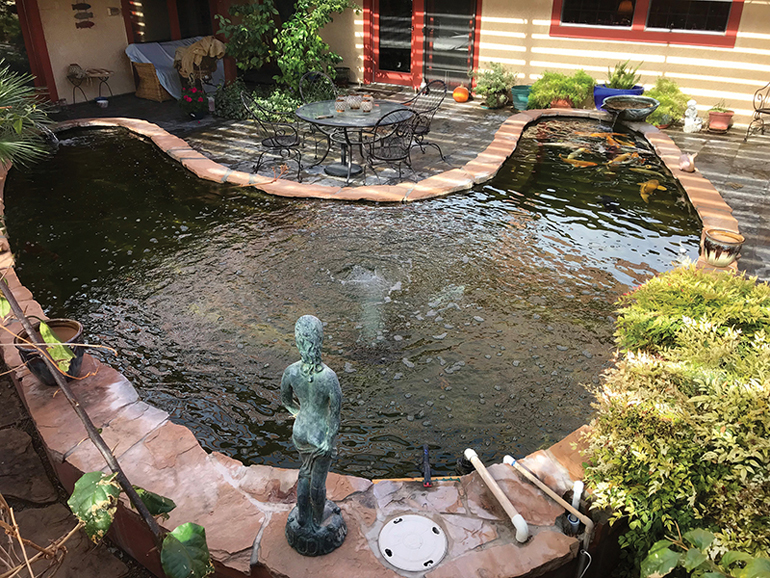
My first pond construction project was in early 1999. My father’s neighbor, Pam, lived in the cul-de-sac behind him and had removed a tree from her courtyard. She approached me and wanted to use the space for a pond like my father had at the time.
At the time, I had just left a 26-year career in the automotive industry and was working on racecars and doing custom iron work out of the shop in my home. My father always had a fish pond of some sort, and all I knew was that it was a lot of work. I agreed to help his neighbor and ended up building out her complete courtyard, including the cover, which was supported by steel beams. I did a month’s worth of research, which consisted of calling every manufacturer listed in KOI USA magazine, because my father had stacks of them lying around. I had a long conversation with William Lim of Wlimproducts.com, who ended up guiding me through the project.
Getting My Feet Wet
Looking back, it was a fairly complicated project for a first-timer. William guided me through installing the filtration system for this boomerang-shaped, raised pond, but “raised” construction of the pond was completely up to me. Because of the shape, the rubber liner had to be seamed, which was another aspect I had to figure out by myself.
It ended up being a great learning experience, and because Pam was a real estate appraiser who worked out of her home office, visitors to her home for business would often ask her who built her pond. Over the next couple of years, I was splitting my time between iron work and pond construction, but I eventually had to decide the direction I would pursue going forward.
Late in 2000, Pam entered her courtyard in a Better Homes and Gardens special-interest issue and won best courtyard nationwide. I used this for some advertising and moved forward from there. Although I was getting comfortable with pond construction, I still had some concerns about the longevity of liner and the amount of work that would be required to replace it at some point in every pond’s future.
Paving the Way
After a couple of years, I started blogging on Koiphen about my projects and repairs to what I considered odd problems I had run into. At one point, I was contacted by a gentleman named Dudley Primo. Dudley was a chemist who held many patents on polyurea coatings, and he asked if I could write an article for him detailing the proper application techniques for the system. Polyurea had been briefly introduced to the pond industry by Tim Zuber through an article in KOI USA magazine, but others were installing it improperly, causing a reputation issue across the entire industry. The polyurea industry was large and encompassed many different areas, but the small segment that was pond construction was causing a lot of grief in the industry because of improper application.
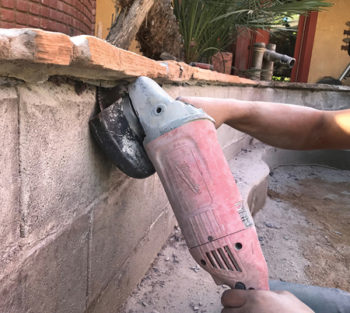
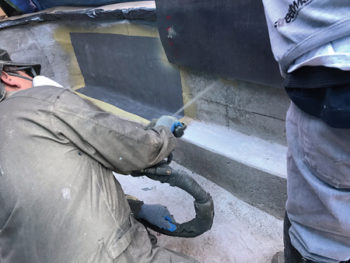
[box]We cut a 45-degree angle for the polyurea attachment and the original surface had to be scraped and cleaned. We applied polyurea and geotextile cloth to the interior of the pond.[/box]
Dudley was going to be in Las Vegas for the upcoming World of Concrete convention and wanted to meet with me. I knew nothing of polyuria, but I had read Tim Zuber’s article, which I found very interesting. I agreed to work with him and had a very informative meeting with Dudley at the convention. He was mostly concerned with mechanical clamping techniques around the penetrations. Later that season, I met Tim Zuber at a koi show in Florida and was duly impressed. Tim, a Seattle native, was training others in polyurea-application techniques.
Over the years, I started using polyurea on any project I could. These days, as a consultant and equipment manufacturer, I suggest polyurea as an option on each project, which brings me back to my first pond build.
Back to the Start
Pam had placed a large flagstone in one end of the pond bottom to place a decorative castle on, and over time its weight had penetrated the liner in a couple of places on the sides that were under the most pressure. I removed the stone and patched her liner, which held for some years.
Years later, Pam passed away, and the home was sold. The new owners were excited about the pond, but after a little while, the patched areas started to leak again. It had been OK for many years, but it had become harder to patch. Replacing the liner would mean removing the entire flagstone top cap.
But after seeing a sample of polyurea, they decided to use it. I had originally built a 1,000-gallon airlift-operated quarantine system in the home’s backyard, which made moving the fish easy. Every pond owner should have a quarantine system of some type available for emergencies or disease management. This system had sat empty for more than 10 years, but it started up easily.
The new owners, Kim and Wally, hired a crew to move the fish and remove the existing liner. On new pond construction, the polyurea would typically be applied over the top of the block or edge treatment, with the top cap or decorative rock used as the mechanical clamp. In this case, a 45-degree cut was made in the top edge of the block just under the flagstone with a diamond saw, providing more surface area for the polyurea to attach to under the top cap without removing it. This worked well, and the return penetrations were reinstalled as originally used for the EPDM liner.
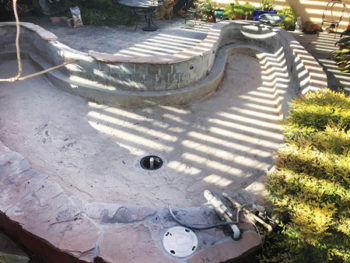
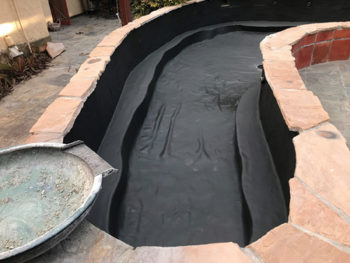
[box]Polyurea was applied on the sides and the top block edge. We added sand to the floor to smooth it out and, right, the finished surface is ready to go.[/box]
Polyurea to the Rescue
Paul Parszik of Artisan Aquatics was brought in to install the polyurea, which turned out great. The original construction had been a block retaining wall on a foundation shelf with a dirt floor and a concrete ring around the bottom drain. All the return penetrations were originally installed in the block retaining wall, so the clamp rings just needed to be unscrewed and cleaned up. The sand floor was reshaped a little, and the block was scraped to remove any glue left over from the original underlayment attachment. Paul used a geotextile cloth to transition from the block onto the sand bottom. The geotextile cloth used for polyurea is much heavier and stronger than that normally used as underlayment for EPDM. The system worked well and turned out beautiful.
The equipment and filtration were still in good working order, so no major repairs were necessary in that respect. The original liner lasted 19 years with some patches that were only necessary because of the improper installation of the underwater flagstone table. With the addition of polyurea, there is no telling how much longer the pond will last.
Polyurea has been speed-tested to more than 75 years and can withstand many tons of rock pressure that liner simply cannot. I’ve even seen a 10-ton boulder dropped on polyurea over geotextile with no damage. Polyurea cannot be penetrated by roots or eaten through by varmints, as is often seen with rubber liner.
Keep polyurea in mind next time you need to replace a liner, or consider how cheap the expense of polyurea is up front on new construction, as opposed to the massive expense of complete replacement down the road.


